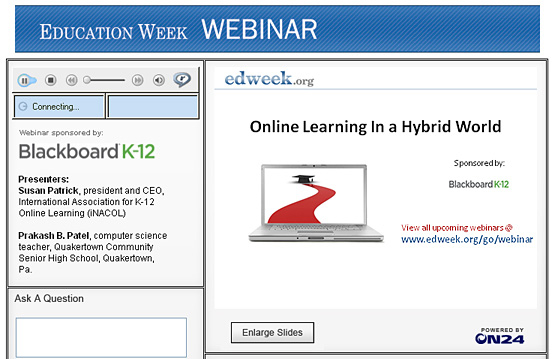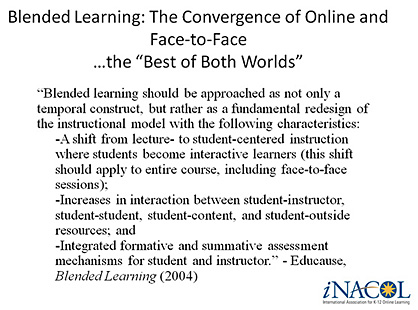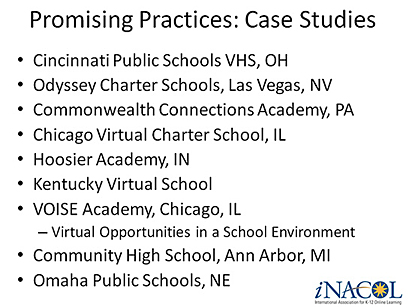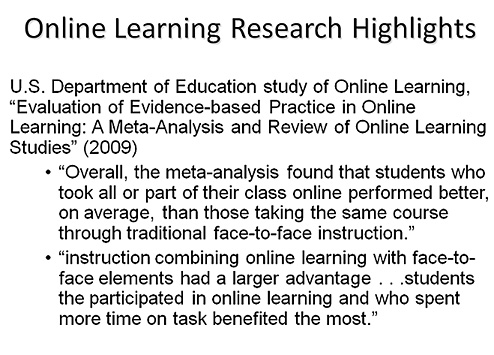Some slides from an Education Week webinar today:




Talking hybrid learning models – Holly Tousignant, Queen’s University Journal — resource and quote below from Ray Schroeder
A pilot project from the Principal’s Taskforce on Virtualization put two different models of virtualization into practice this past year. Leger said students in POLS 110 and BIOL102 were polled throughout the process to gauge their approval. More than 80 per cent of students polled in both courses found it useful or extremely useful, he said, adding that none of the professors involved noticed a significant drop in attendance. “The students actually said they listened more in class. … They’re worried less about taking notes, they’re worried less about missing something,” he said. Leger said while the first model of virtualization used the lecture-capture system to supplement lectures, the second model used videos alone for some students in BIOL102, which is split into sections A, B and C. Students in sections A and B were given lecture periods and video access, while students in section C only had video access. He called this model “hybrid virtualization.”
Hybrid learning: Instructional and institutional implementation — from Academic Impressions
Learn how to address critical components of hybrid learning.
In order to have a succesful hybrid learning initiative, institutions must have several components in place: a hybrid (re)design faculty development program, technical support of instructional technologies, and a sound institutional implementation plan. Join us online to learn how to address each of these critical components and others.
WHAT YOU WILL LEARN
— An overview of the hybrid model and the 21st century learner
— Guidelines and best practices for institutional implementation
— Marketing to students
— Student readiness
— Quality assurance
— A ready-to-use hybrid redesign program
The benefits of blended learning — from Faculty Focus
Blended learning, which combines face-to-face learning with a mixture of online activities, has been hailed as both a cost-effective way to relieve overcrowded classroom and a convenient alternative to the traditional classroom experience. But it has quickly become much more than that.
“There’s a growing body of evidence that suggests blended courses really are an effective way for students to learn,” says Ike Shibley, PhD, associate professor of chemistry at Penn State-Berks. “Blended courses can actually lead to increased student engagement, not less (emphasis DSC).”
But for blended learning to work well for you and, more importantly, your students, it requires a fair amount of upfront prep time in advance of the course and the discipline to stick to your course plan. More so than in traditional face-to-face courses, Shibley says.
Carnegie Mellon’s Open Learning Initiative — learningonlineinfo.org — March 7, 2010
“What a wonderful initiative! Carnegie Mellon’s Open Learning Initiative: Using intelligent tutoring systems, virtual laboratories, simulations, and frequent opportunities for assessment and feedback, the Open Learning Initiative (OLI) builds courses that are intended to enact instruction – or, more precisely, to enact the kind of dynamic, flexible, and responsive instruction that fosters learning.”
And from:
http://oli.web.cmu.edu/openlearning/
Hybrid Education 2.0
[…] the researchers seem more excited by a hybrid application of the open-learning program that, instead of replacing professors, tries to use them more effectively. By combining the open-learning software with two weekly 50-minute class sessions in an intro-level statistics course, they found that they could get students to learn the same amount of material in half the time (emphasis DSC).
“If they’re all getting that baseline information, [faculty] can spend that class time going deeper and doing something much more interesting, so they can really leverage that you’re an expert,” says Candace Thille, director of the Open Learning Initiative, “because right now, oftentimes the faculty expertise is wasted.” (emphasis DSC).
New hybrid PhD program at MSU — from Michigan State University
From Dr. Patrick Dickson of MSU College of Education:
I would like to let you know of the new hybrid avenue to earning the Michigan State University Ph.D. in Educational Psychology and Educational Technology with an emphasis in educational technology and online learning.
The faculty decided to offer this substantially online pathway to our PhD in response to the interest among professionals who wish to continue in their current positions while earning their doctorate.
The hybrid program is designed for the bright, established professionals currently serving in K-12 schools, universities, policy centers, and research institutions, who understand how new technologies, including online learning, continue to transform education.
RENCI pioneering the visualization industry with innovative interfaces — from InnovativeInteractivity.com by Tracy Boyer
“Today I flew through a digitally enhanced simulation of an ear canal, looked at 3D manipulations of static 2D images, and watched a seamless video projected simultaneously on four surrounding walls. The Renaissance Computing Institute (RENCI) is based in North Carolina and oddly enough it was my first visit to this extremely innovative and eye-opening interactive institute. Not only did it get me excited about information visualization, it gave me tons of inspiration for the future of immersive and interactive multimedia. Here is a great overview video of a similar tour group that went through RENCI. I experienced the first two visualizations that are shown here…”